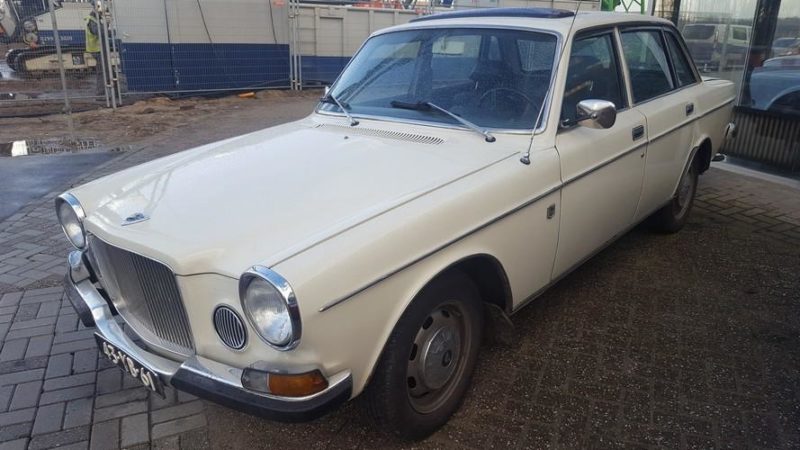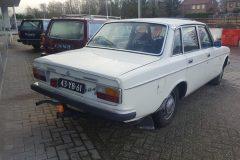The Volvo 164 is a luxury automobile, based on the 140 series. A large, stately automobile. A car with an almost British chic looking nose. With a large 3 liter engine (which later received injection). The Volvo 164 was sold between 1969 and 1975. And is much less popular than the older Amazons and the younger 470s. Maybe it's the type designation. Alfa Romeo's 164 also deserved more success.
Could have been even bigger
The Volvo 164 was signed by Jan Wilsgaard, and was based on the P358 concept car that he had devised in the 50 years. That P358 had an 3,6 liter V8 engine, independent front suspension and disc brakes all around. Volvo wanted to compete against it on the American market against Mercedes-Benz. Because the demand for a V8 did not seem large enough, this version was not put into production.
But in 1968 his successor or evolution model was presented: the 164. The engine got two cylinders less and the bodywork was 'photoshopped'. The 164 is clearly an almost image of the 140 series. The biggest difference is in the nose and the engine. From 1968 to 1971, the cars are equipped with a six-cylinder B30A engine. This one has Zenith Stromberg 175CD2SE carburetors. From 1971 the electronic injection came from Bosch.
A bit of history
The Americans wash their ears with a V8 and wipe Mercedes-Benz off the map was not. But also with the three-liter six-in-line, the Volvo 164 was a stately, chic automobile from the clearly higher segment.
1969 was the first year that the Volvo 164 was produced. The basis for the design was the 144, but with a characteristic = chic nose. That 'nose job' was also needed to make room for the six-cylinder B30A push rods in-line engine (which was based on the four-cylinder blocks). The transmission was enhanced compared to the 144 and the interior was clearly more luxurious than the 144. In 1972 the 164 got another block: the B30E / F. And injection was optional. With such an 175 horsepower and an impressive couple, those Volvo cars were 'muscle cars' even in American eyes. The front discs were ventilated from that moment, a not bad idea with such a lump of iron under the hood. 1973 Was the year of a major (visual) update. In 1974, the large Volvo became even safer in the passive area. In 1975 you could already see that the 200 series was coming. All in all, such an 150.000 Volvo six-speed have been made.
A daily driver
Our photo model - it is not overflowing with 164s in the Netherlands - we found at Wim Bottinga, the classic Volvo specialist from Barneveld. Wim is a Volvopassionado who has enthusiasts with top restored 164s in his clientele. But the white 164 with leather trim that he currently has is not a showpiece. It is an LPG and petrol-powered model that is simply suitable for everyday use. The price of this 164 with patina is a good indication of the price of a normal honest copy: Wim asks for € 3.999 for it. And that is much less than the value of the car he is currently restoring. But we will come back to that. When that is done uniquely.







That story of the V8 is wrong in my opinion. The Volvo 164 also has a 6 in-line engine. Later Volvo, Peugeot and Renault wanted to develop a V8 engine (eg for the Volvo 264/265), but due to the oil crises, 2 cylinders were removed and a V6 with an unusual block angle of 90 degrees was created. This engine was later used in the Volvo 264, the Renault 25 and 30, the Renault Alpine, the DeLorean and the Peugeot 504 coupe and 604 and many other cars.
Surhuisterveen, in Friesland, has had a 164 in increasingly deplorable condition for years …… ..
Last time I passed it, recently, my eyes were wet with grief, 10 years back with joy!
Hey hey, is that Volvo still there?
No it's gone, I saw it recently
The 200 series was not coming in 1975, it was already there at the end of 1974.
And in the aforementioned that the V6 from Peugeot and others should have been a V8 is not known to me, as an old Peugeot employee. The 60 degree angle was needed to get the whole in the 504 coupe.
The subsequent V6 engine should also have been a V8. Because the PRV block (developed by Peugeot-Renault-Volvo) was originally intended as a V8, but has become a V70 due to the oil crisis in the early 6s. The block angle of 60 degrees still refers to the V8. This engine (2,7 - 2,9 liters) was used from 1975 to the early 90s in many different cars from Peugeot 504, Volvo 264, Renault 30 to Lancia Thema, Delorean, Renault Alpine A610. (And much more).